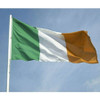Description
The luck of the Irish will be all yours when you fly the mighty flag of Ireland, also known as the Irish Tricolor.
Whether you’re celebrating Saint Patrick’s Day or want to display your love of Irish history year-round, these bright, bold flags of Ireland are an excellent piece of Celtic decor. Best of all, this high-quality flag is made of 100% nylon, ensuring your flag is strong and durable.
Our Ireland flags are available in six different sizes for outdoor flying, including 12” x 18”, 2’ x 3’, 3’ x 5’, 4’ x 6’, 5’ x 8’, and 6’ x 10’. The 3’ x 5’ Republic of Ireland flag is a bestseller among our customers and is a great choice for our 6’ house-mounted flagpole.
Ireland’s Flag Features:
- Manufactured in the USA with high standards of quality
- Authentic 1848 design
- 100% fray-resistant nylon
- Robust canvas heading
- Brass grommets for easy mounting
Our indoor Ireland flags, which come adorned with gold fringe and a pole sleeve, are ideal for formal displays.
Irish Flag Colors, Meaning & History
While the tricolor pattern may seem somewhat plain, the colors of the Irish flag symbolize hundreds of years of rich Irish history. Each color represents a different historical movement, and the colors together represent lasting peace between Ireland’s people. Green stands for Ireland’s Roman Catholic population, while orange represents the Protestants, as led by William of Orange. The white in the center conveys trust and union between the two religious factions.
The flag of Ireland was created in 1848 by a few French women, who gave the flag as a gift to Thomas Francis Meagher, a leader of the Irish independence movement.
Fun Fact!
Although the flag has been considered the national flag of Ireland since it was first raised during the Easter Rising of 1916, it was not officially confirmed by the Constitution of Ireland until some twenty years later, in 1937.
Other Details
Language(s): Irish, English
Currency: Euro €
Government: Unitary Parliamentary Constitutional Republic
Flag Meaning: The green represents the Gaelic tradition, the orange stands from the followers of William of Orange, and the white symbolizes the desire for peace between them.










